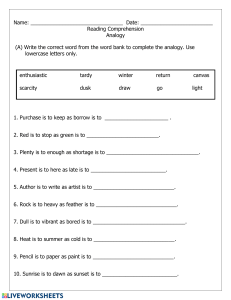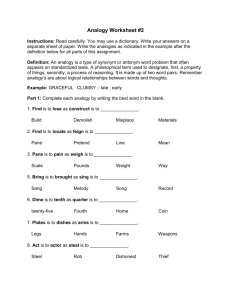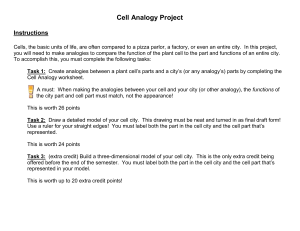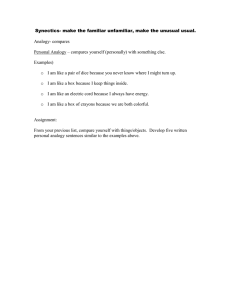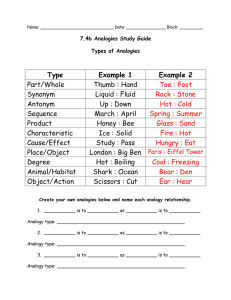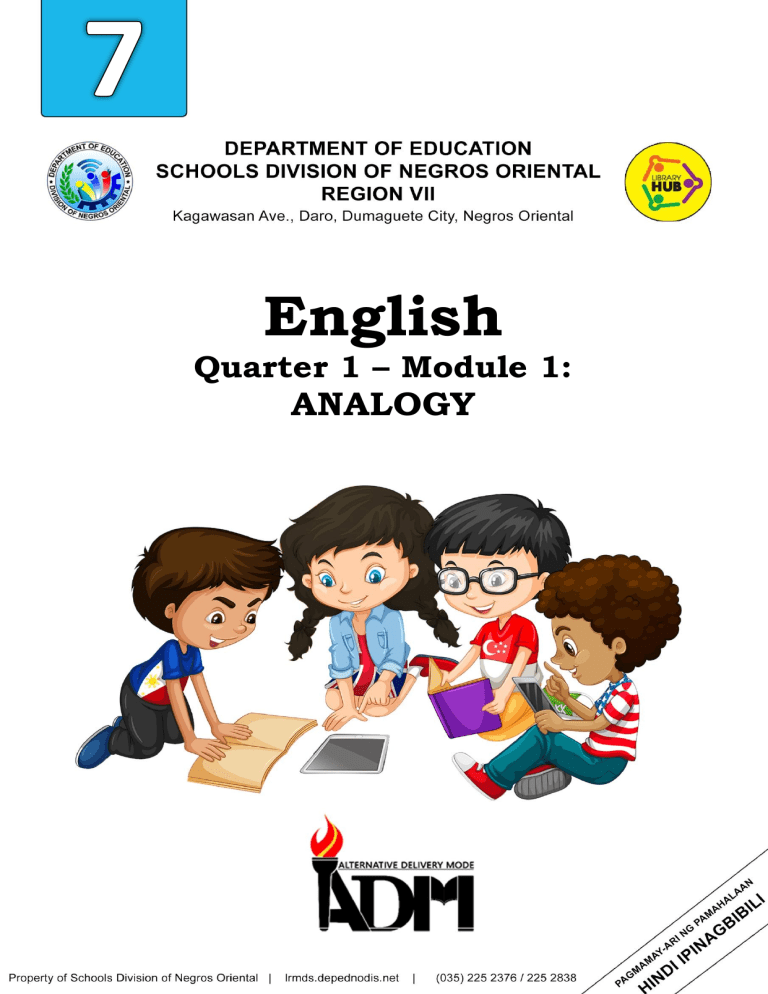
English Quarter 1 – Module 1: ANALOGY 000000000000000000000000 English – Grade 7 Alternative Delivery Mode Quarter 1 – Module 1: Analogy First Edition, 2020 Republic Act 8293, section 176 states that: No copyright shall subsist in any work of the Government of the Philippines. However, prior approval of the government agency or office wherein the work is created shall be necessary for exploitation of such work for profit. Such agency or office may, among other things, impose as a condition the payment of royalties. Borrowed materials (i.e., songs, stories, poems, pictures, photos, brand names, trademarks, etc.) included in this module are owned by their respective copyright holders. Every effort has been exerted to locate and seek permission to use these materials from their respective copyright owners. The publisher and authors do not represent nor claim ownership over them. Published by the Department of Education Secretary: Leonor Magtolis Briones Undersecretary: Diosdado M. San Antonio Development Team of the Module Writer: Ma. Antonieta Q. Bacang Editor: Jessie Lou L. Ecleo Reviewers: Leizl A. Elli and Jessie Lou L. Ecleo Illustrator: None Layout Artist/Typesetter: Mae Ricarl S. Moreto Management Team: Senen Priscillo P. Paulin, CESO V Rosel R. Abiera Fay C. Luarez, TM, Ed.D., Ph.D Maricel S. Rasid Nilita L. Ragay, Ed.D. Elmar L. Cabrera Adolf P. Aguilar Anna Lee A. Amores, Ed.D. Printed in the Philippines by ________________________ Department of Education –Region VII Schools Division of Negros Oriental Office Address: Tele #: E-mail Address: Kagawasan, Ave., Daro, Dumaguete City, Negros Oriental (035) 225 2376 / 541 1117 negros.oriental@deped.gov.ph 7 ENGLISH Quarter 1 – Module 1 ANALOGY Introductory Message For the Facilitator: Welcome to the English 7 Alternative Delivery Mode (ADM) Module on Analogy! This module was collaboratively designed, developed and reviewed by educators both from public and private institutions to assist you, the teacher or facilitator in helping the learners meet the standards set by the K to 12 Curriculum while overcoming their personal, social, and economic constraints in schooling. This learning resource hopes to engage the learners into guided and independent learning activities at their own pace and time. Furthermore, this also aims to help learners acquire the needed 21st century skills while taking into consideration their needs and circumstances. In addition to the material in the main text, you will also see this box in the body of the module: Give learners an uncommon experience. As a facilitator, you are expected to orient the learners on how to use this module. You also need to keep track of the learners' progress while allowing them to manage their own learning. Furthermore, you are expected to encourage and assist the learners as they do the tasks included in the module. ii For the Learner: Welcome to the English 7 Alternative Delivery Mode (ADM) Module on Analogy! This module was designed to provide you with fun and meaningful opportunities for guided and independent learning at your own pace and time. You will be enabled to process the contents of the learning resource while being an active learner. This module has the following parts and corresponding icons: What I Need to Know This will give you an idea of the skills or competencies you are expected to learn in the module. What I Know This part includes an activity that aims to check what you already know about the lesson to take. If you get all the answers correct (100%), you may decide to skip this module. What’s In This is a brief drill or review to help you link the current lesson with the previous one. What’s New In this portion, the new lesson will be introduced to you in various ways; a story, a song, a poem, a problem opener, an activity or a situation. What is It This section provides a brief discussion of the lesson. This aims to help you discover and understand new concepts and skills. What’s More This comprises activities for independent practice to solidify your understanding and skills of the topic. You may check the answers to the exercises using the Answer Key at the end of the module. What I Have Learned This includes questions or blank sentence/paragraph to be filled in to process what you learned from the lesson. iii What I Can Do This section provides an activity which will help you transfer your new knowledge or skill into real life situations or concerns. Assessment This is a task which aims to evaluate your level of mastery in achieving the learning competency. Additional Activities In this portion, another activity will be given to you to enrich your knowledge or skill of the lesson learned. Answer Key This contains answers to all activities in the module. At the end of this module you will also find: References This is a list of all sources used in developing this module. The following are some reminders in using this module: 1. Use the module with care. Do not put unnecessary mark/s on any part of the module. Use a separate sheet of paper in answering the exercises. 2. Don’t forget to answer What I Know before moving on to the other activities included in the module. 3. Read the instruction carefully before doing each task. 4. Observe honesty and integrity in doing the tasks and checking your answers. 5. Finish the task at hand before proceeding to the next. 6. Return this module to your teacher/facilitator once you are through with it. If you encounter any difficulty in answering the tasks in this module, do not hesitate to consult your teacher or facilitator. Always bear in mind that you are not alone. We hope that through this material, you will experience meaningful learning and gain deep understanding of the relevant competencies. You can do it! iv TABLE OF CONTENTS CONTENT TITLE PAGE PAGES ------------------------------------------------ i INTRODUCTORY MESSAGE --------------------------------For the Facilitator --------------------------------For the Learner ----------------------------------------- ii ii iii WHAT I NEED TO KNOW Learning Competency Learning Objectives ------------------------------------------------------------------------------------------------- 1 2 2 WHAT I KNOW ------------------------------------------------ 2 WHAT’S IN Task 1 Task 2 ---------------------------------------------------------------------------------------------------------------------------------------------- 3 3 4 WHAT’S NEW ------------------------------------------------ 4 WHAT IS IT ------------------------------------------------ 5 WHAT’S MORE ------------------------------------------------ 7 WHAT I HAVE LEARNED WHAT I CAN DO ASSESSMENT --------------------------------- 8 ---------------------------------------- 8 ------------------------------------------------ 9 ADDITIONAL ACTIVITIES ANSWER KEYS REFERENCE LIST --------------------------------- 12 ------------------------------------------------ 13 -------------------------------------------- 14 v WHAT I NEED TO KNOW Hi! How are you today? I hope you woke up with a smile on your face. Cheer up! Everyday has a reason for you to be awake, active and enthusiastic. Today, we will learn something about analogy. In our day to day activities, good communication is really an important factor to establish understanding between or among individuals. Most often, we want to be heard, we want to express what is in our minds and reasoning is a potent way of expressing ourselves, to stress the points that we want to emphasize. In this manner, a well-developed skill in making and understanding analogy will cater to this purpose. If you hear the word “ANALOGY”, you will think about comparison and relationship of words. But people often wonder about the effectiveness of analogies. What do they teach? How do they work? Why are they so useful? What skill is developed if a student is really good in analogy? All of these ideas are to be taken into consideration as you move forward to this lesson. This module provides discussion about the lesson with appropriate examples and activities for you to browse and answer religiously. The activities are simply designed to cater to your needs in developing your critical thinking skill in finding the word relationship and functions. As you journey with the lesson on analogy, you will understand each of its categories and eventually can make use of them not only for English classes but to your other academic subjects. Begin by reading and understanding the Most Essential Learning Competencies and Learning Objectives. These will tell you what you should know and be able to do at the end of every lesson. It is not enough that you acquire content or information. You must be able to demonstrate what you learned by doing the activities prepared for you. In other words, you must be able to digest the lesson through your effort in giving answers to all activities in your activity notebook. 1 Learning Competency Supply other words or expressions that complete an analogy. EN7V-IV-c-23.1 Learning Objectives At the end of the module, you should be able to: 1. 2. 3. 4. Define analogy and its categories. (Cognitive) Complete analogical sentences. (Psychomotor) Appreciate the use of analogy in reasoning. (Affective) Display the value of patience in making analysis in the relationship of words. (Attitude) Please take note that all answers shall be written in your activity notebooks, and that there should never be any markings placed in this module. WHAT I KNOW Pre-assessment: Direction: Look at the following examples. Think of the relationship between the underlined words. Then, complete the analogical sentence by picking up the best word from the given choices after each statement. Write the letter of your choice in your notebooks. 1. Claw is to cat as tail is to _____. a. wag b. story c. tooth d. dog 2. Violinist is to orchestra as pitcher is to ______. a. band b. baseball team c. juice d. instrument Are you done? Let’s try to illustrate your answers through the following questions. Think, and express your answers freely on your notebook. 2 1. What are your choices both in Item 1 and Item 2? 2. How did you come up with those choices? 3. What have you noticed about the first two underlined words? 4. How are these two underlined words related? What is their relationship? 5. Are you using the same relationship in finding the pair of the third underlined word? WHAT’S IN Task 1 Directions: Read each analogical sentence. Exercise your reasoning ability and justify your answers to the given questions. Learn and be guided with the category of analogy presented to you. A. Function Performer is to action as painter is to paint. What is the function of the performer? What does a painter do? B. Degree Warm is to hot as cold is to freezing. What happens to the degree of heat? What happens to the degree of coldness? C. Characteristic Bird is to air as fish is to water. What do birds do? What do fishes do? D. Kind Laughing is to crying as happy is to sad. How does laughing relate to crying? How about happy and sad? E. Part to whole Fin is to fish as wing is to bird. What will happen to a fish without its fin? What will happen to a bird without a wing? F. Definition Life is a race as to death is a phase. How does life being defined? How does death being defined? 3 Great! Let’s try some more. This time visually enjoy the sets of analogical sentences below. I know that this will be easier for you to do. Task 2 Directions: Pick out the exact word to complete each sentence. Write the letter of your answer directly to your notebook. 1. FIND is to LOCATE as LOSE is to _________________. a. Find b. Locate c. Misplace d. Place 2. DOOR is to KEY as SHOE is to _________________. a. Hinge b. Transom c. Shoelace d. Threshold 3. SMOKE is to FIRE as WATER is to _________________. a. Sky b. Rain c. Cloud d. H2O 4. ISLAND is to ARCHIPELAGO as SLICE is to _________________. a. Loaf b. Peninsula c. Land d. Ocean 5. HAND is to ELBOW as FEET is to_________________. a. Leg b. Toe c. Muscle d. Knee 6. COMMAND is to PARENTS as OBEY is to_________________. a. Teachers b. Children c. Armies d. Principals 7. EGG is to BOILED as POTATO is to_________________. a. Hash b. Smash c. Slice d. Slash 8. DIG is to EXCAVATE as KILL is to _________________. a. Slay b. Convict c. Coverage d. Try 9. POSSIBLE is to PROBABLE as HOPE is to _________________. a. Expect b. Prove c. Deceive d. Resent 10. RICHNESS is to WEALTH as WISDOM is to _________________. a. Knowledge b. Save c. Divulge d. Teach WHAT’S NEW That must have been a tough accomplishment but you’re doing just fine! Now, I want you to go into a deeper understanding of the activities that you went through actively. READ and take your time to get the important points about this lesson on ANALOGY. An analogy is a statement of comparison between two different things, ideas or concepts. What makes analogies so effective is their ability to get someone to think critically. To answer an analogy question correctly, a person has to form a logical relationship, or "bridge" between two words. He or she must think about how the words are related and understand that words can be related in different ways. It is, therefore, the task of the person to focus on the most essential relation, the most basic aspect of the word’s function or definition. 4 WHAT IS IT There are several primary categories of relationships used in forming analogies: A. Function – It can be an activity or purpose intended for a thing or a person to do. This relationship is based on the way something operates or is used. It can also be called as purpose analogy. Take this example: Performer is to action as painter is to paint. What is the function of the performer? What does a painter do? Explanation: The performer will do some actions on stage or in front of a crowd to entertain them because that is the performer’s function. The same explanation it is with the painter whose job or function is to do the painting. To see the relationship, it would be necessary to be knowledgeable on how an object is to be used, as well as, on how a certain person does his job. B. Degree- the extent of which something happens. This relationship shows the greater or lesser amount of intensities of action or description. Take this example: Warm is to hot as cold is to freezing. What happens to the degree of heat? What happens to the degree of coldness? Explanation: In a usual situation, what started as simple can become complicated. There is always a gradual increase in something that you do. Say, if you are putting water in the freezer, it will eventually freeze after several hours or, if you intend to boil water, it becomes warm then after a few minutes it will reach its boiling point. These illustrate that any activity will come to a point of completion after reaching its limits. C. Characteristic – a quality typical to a person or thing. This indicates the features which are known to be true to a certain object, person, animals or ideas. You can identify something through its characteristics. Take this example; Bird is to air as fish is to water. What do birds do? What do fishes do? 5 Explanation: We are familiar with birds, aren’t we? Birds are known to play in the air, they fly. Flying is a distinct characteristic of birds. On the other hand, fishes swim. Swimming is their distinct characteristic. Enough knowledge about the features of a particular thing, person, or animals, will make characteristic analogy easier. D. Part to whole – a fraction that represents a whole. This explains that all parts of a certain object or even in a human being are all important. Each of these parts plays an important role to make the whole thing functional. Fin is to fish as wing is to bird. What will happen to a fish without its fin? What will happen to a bird without a wing? Explanation: The fin is a significant part of a fish and without it, the fish can’t swim and will eventually die. Wings are essential to birds, and though not all birds are able to fly, like kiwi birds that are wingless, but when we talk about an animal that has wings, it is mostly a bird. E. Antonyms/Synonyms – pairs that show an opposite relationship/pairs that show a similar relationship. These can be very important in developing your vocabulary skill. The knowledge of antonyms or words with opposing meanings and of synonyms or words with the same or similar meanings will help specifically in doing writing activities. Take these examples: empty: full::awkward: graceful Explanation: Those above are antonyms. The opposite of the word empty is full, and the word awkward is graceful. pretty: gorgeous::sad: mournful Explanation: Those above are synonyms. The word pretty has the same meaning as the word gorgeous, and the word sad has the same meaning as the word mournful. F. Classification – identify something into its category. This category of analogy will tell us to put together words, objects, or ideas that belong to the same group or of the same general identification. See these examples: Ballet:Dance::Frog:Amphibian Explanation: Ballet is classified as dance, just like a frog is classified as an amphibian. 6 WHAT'S MORE ANALOGY plays a significant role in solving problems, making decisions, reasoning in arguments, expressing perceptions, making generalizations, predicting outcomes, and many more. It is an important part of high-level perception in humans; the ability to form and understand analogies requires high cognitive functioning. So, when a student works with the different areas of analogy, he or she needs to play with his or her encounter with the environment and recall experiences with situations he or she has on things, with people, with places or even with ideas. With these, a student can easily trace how things relate to one another. Now, with the preceding explanation, test your learning with the next sets of exercises. Feel free to make mistakes and do corrections right away. Have fun! Do more for analogies… Exercise A. Determine what the relationship is between the first two words in each analogy. Then complete the analogy with one of the words in parenthesis. If you are unsure of a word’s meaning, consult a dictionary for clarification. Write your answer directly in your notebook. 1. 2. 3. 4. 5. begin : end : : open : _____ detective : inspector : : teacher : _____ incognito : disguised : : foolish : _____ insect : mosquito : : dog : _____ nose : face : : elbow : _____ (reach, unlock, close) (professor, student, child) (smart, funny, senseless) (cat, bone, collie) (arm, wrist, knee) Exercise B. Determine what the relationship is between the first two words in each analogy. Then complete the analogy with one of the pair words in parenthesis. If you are unsure of a word’s meaning, consult a dictionary for clarification. Write your answer directly in your notebook. 1. 2. 3. 4. 5. pick : select : : _________ center : middle : : _________ neighborhood : city : : _________ want : desire : : _________ top : bottom : : _________ 7 (window: ladder, couch: sofa) (sea: ocean, fish: land) (game: end, pupil: class) (find: discover, remain: fall) (large: small, huge: many) WHAT I HAVE LEARNED Directions: Review the lesson on ANALOGY. Then write your reflection in your notebook by finishing up the unfinished statements below. I have learned that ________________________________________________________ ___________________________________________________________________________ I have realized that _______________________________________________________ __________________________________________________________________________ I will apply _______________________________________________________________ ___________________________________________________________________________ WHAT I CAN DO Directions: In the following, try to determine the relationship between the first pair of words given below. From the four choices, choose the pair of words that have the same relationship as the original pair of words. Write in your notebook the letter of your choice before each number. _____ 1. Ensue : follow : : A. run : lead B. pursue : chase C. permit : play D. object : quit _____ 2. Chamber : room : : A. diary : record B. garage : house C. privacy : property D. title : book _____ 3. Chaos : order : : A. stinginess : strictness B. regulation : rule C. moisture : droplets D. cowardice: courage 8 _____ 4. Astound : amaze : : A. blend : separate B. postpone : delay C. afford : sell D. excel : surprise _____ 5. Dwindle : shrink : : A. begin : start B. grow : plant C. forego : choose D. attend : disappear ASSESSMENT Finally, you were able to tackle the different related activities to sharpen your skills on analogy. Now, it’s time to evaluate your learning. Be ready…go! Directions: Below are sets of analogy activities. Answer them according to each subtest instructions. Write your answers clearly in your notebook. A. Complete each analogy sentence by writing the correct word on the blank line. Think critically. 1. 2. 3. 4. 5. 6. 7. 8. 9. 10 Mouse is to mammal as snake is to __________. Sound is to hear as odor is to __________. Oven is to bake as knife is to __________. Morning is to breakfast as evening is to __________. Sing is to sang as eat is to __________. Top is to bottom as over is to __________. Day is to month as minute is to __________. Word is to sentence as page is to __________. Go is to green as red is to __________. . Toe is to foot as finger is to__________. 9 B. Complete the illustration by providing the appropriate drawing on the blank space. Write the letter of your answer directly on your notebook. 1. 2. 3. 4. 5. 6. 7. 8. 9. 10. Source: http://questionpaper.org/non-verbal-analogy/ 10 C. Use the words inside the box to form five (5) sets of analogy. Write your answers in your notebooks. volcano light sky dark table read song bed sing pizza cheese ice cream comforter sprinkles snow lava tablecloth day book night 1. ______________:_______________::______________:_______________ 2. ______________:_______________::______________:_______________ 3. ______________:_______________::______________:_______________ 4. ______________:_______________::______________:_______________ 5. ______________:_______________::______________:_______________ Alright! You have done a very good job. You can make use of what you have learned about an analogy in your daily activities, as well as, in your other subjects that need analysis. Continue exploring the world of analogies. You can take a short break, stretch your muscles, take your snacks, drink your juice or a glass of water, do personal necessities. Feel relax, then, return to your study table and do more related activities… 11 ADDITIONAL ACTIVITIES A. Directions: Identify the category of analogy reflected in the following lines. Choose from the list of categories found inside the box below. Write your answer directly to your activity notebook. kind function antonyms part to a whole degree cause & effect characteristic synonyms definition 1. A fork is used to eat. 2. The sun is so hot. 3. A lamb is a baby sheep. 4. Something that is huge is big 5. A shovel is used to dig. 6. A rose is a flower. 7. Chef is for restaurant. 8. The past comes before the present 9. Progress is advancement. 10.Laziness results to failure. B. Directions: Complete each analogy statement by adding an appropriate word on the blanks. Write your answers in your notebook. 1. Papers are to folders as books are to _______________. 2. Time is to clock as temperature is to ______________. 3. Listen is to hear as look is to _____________________. 4. Brother is to sister as aunt is to ___________________. 5. Lead is to pencil as ink is to ______________________. 6. The flag is to freedom as heart is to ________________. 7. Noon is to lunch as evening is to __________________. 8. Inside is to basketball as outside is to ______________. 9. Cooking is to stove as washing is to ________________. 10.Nurse is to doctor as secretary is to ________________. www.teach-nology.com 12 13 ANSWER KEYS Pre-Assessmen t 1.d-dog 2 .b - b ase b all team What’s In Task 2 1.c-misplace 2.c-sh oe lace 3 . b - r a in 4.a-loaf 5.d-kne e 6.b-children 7 .a - h ash 8.a-slay 9.a-expe ct 1 0 . a - k n o w le d g e What I Have Learn ed Ex ercise A 1.close 2 .p r ofe ssor 3 . s e n s e le s s 4.collie 5.arm Ex ercise B 1.couch:sofa 2 .se a:oce an 3.pupil:class 4.find:discover 5.large:small Additional Activities A. 1. Function 2. characteristic 3. Definition 4. degree 5. function 6. kind 7. function 8. antonym 9. synonym 10. cause& effect Assessment A. 1. reptile 2. smell 3. slice 4. dinner 5. ate 6. under 7. hour 8. book 9. stop 10. hand B. 1. Pages 2. thermometer 3. see 4. uncle 5. Pen 6. Love 7. Dinner 8. Volleyball 9. Basin/ Washing machine 10. manager B. 1. A 2. E 3. B 4. D 5. A 6. D 7. A 8. E 9. C 10. B 11. B 12. E 13. E 14. C 15. A C. 1. 2. 3. 4. 5. Day: night::light :dark song:sing::book:re ad table :table cloth::be d:comforter volcano:lava:: sky: snow pizza:cheese:: ice cream: s p r i n k le s Wh at I Can Do 1.B 2.A 3.D 4.B 5.A REFERENCES JD Norton - Manuscript, http://www. pitt. edu/jdnorton/papers …, 2011 Ogles,Kaitlin.ClassificationAnalogies:Definition&Types.https://study.com/ academy/lesson/classification-analogies-definition-types.html P Bartha - 2013 Analogy and analogical reasoningplato.stanford.edu https://examplesyourdictionary.com/analogyex.html https://englishforeveryone.org/topics/analogies.hyml https://www.masterclass.com/articles/what-is-analogy https://questionpaper.org/reasoning-questionswww.Teach-nology.com https://www.indiabix.com/non-verbal-reasoning/analogy/ https://literaryterms.net/analogy/ 14 For inquiries or feedback, please write or call: Department of Education – Schools Division of Negros Oriental Kagawasan, Avenue, Daro, Dumaguete City, Negros Oriental Tel #: (035) 225 2376 / 541 1117 Email Address: negros.oriental@deped.gov.ph Website: lrmds.depednodis.net 15
